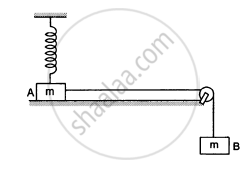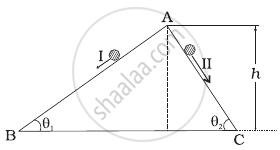Advertisements
Advertisements
प्रश्न
A body is falling freely under the action of gravity alone in vacuum. Which of the following quantities remain constant during the fall?
पर्याय
Kinetic energy.
Potential energy.
Total mechanical energy.
Total linear momentum.
उत्तर
Total mechanical energy.
Explanation:
As the body is falling freely under gravity, the potential energy decreases continuously and kinetic energy increases continuously as all the conservative forces are doing work. So, the total mechanical energy (PE + KE) of the body will be constant.
Let us discuss this in detail:
In the given diagram an object is dropped from-a height H from the ground.
At a point, The total mechanical energy will be EA = K.E + P.E
`E_A = 1/2 mv^2 + mgH`
As velocity will be zero at A, so its kinetic energy will be zero.
`E_A = mgH`
Velocity at point B will be, `v_B = sqrt(2gh)`
So energy at point B will be `E_B = KE + PE`
`E_B = 1/2 m(2gh) + mg(H - h)`
`E_B = mgh + mgH - mgh`
`E_B = mgH`
Now, velocity at point C will be `v_c = sqrt(2gh)`
So, energy at point C will be `E_C = KE + PE`
So, total mechanical energy will remain the same (if we neglect the air friction).
APPEARS IN
संबंधित प्रश्न
A body is initially at rest. It undergoes one-dimensional motion with constant acceleration. The power delivered to it at time t is proportional to ______.
A person trying to lose weight (dieter) lifts a 10 kg mass, one thousand times, to a height of 0.5 m each time. Assume that the potential energy lost each time she lowers the mass is dissipated.
- How much work does she do against the gravitational force?
- Fat supplies 3.8 x 107J of energy per kilogram which is converted to mechanical energy with a 20% efficiency rate. How much fat will the dieter use up?
A particle is rotated in a vertical circle by connecting it to a string of length l and keeping the other end of the string fixed. The minimum speed of the particle when the string is horizontal for which the particle will complete the circle is
Figure shows a particle sliding on a frictionless track which terminates in a straight horizontal section. If the particle starts slipping from point A, how far away from the track will the particle hit the ground?

In the following figure shows two blocks A and B, each of mass of 320 g connected by a light string passing over a smooth light pulley. The horizontal surface on which the block Acan slide is smooth. Block A is attached to a spring of spring constant 40 N/m whose other end is fixed to a support 40 cm above the horizontal surface. Initially, the spring is vertical and unstretched when the system is released to move. Find the velocity of the block A at the instant it breaks off the surface below it. Take g = 10 m/s2.

A spring of negligible mass and force constant 5 Nm–1 is compressed by a distance x = 5 cm. A block of mass 200 g is free to leave the end of the spring. If the system is released, what will be the speed of the block when it leaves the spring?
Two inclined frictionless tracks, one gradual and the other steep meet at A from where two stones are allowed to slide down from rest, one on each track as shown in figure.

Which of the following statement is correct?
A mass of 5 kg is moving along a circular path of radius 1 m. If the mass moves with 300 revolutions per minute, its kinetic energy would be ______.
A bob of mass m suspended by a light string of length L is whirled into a vertical circle as shown in figure. What will be the trajectory of the particle if the string is cut at
- Point B?
- Point C?
- Point X?

A single conservative force acts on a body of mass 1 kg that moves along the x-axis. The potential energy U(x) is given by U (x) = 20 + (x - 2)2, where x is in meters. At x = 5.0 m the particle has a kinetic energy of 20 J, then the maximum kinetic energy of body is ______ J.
